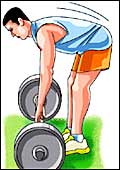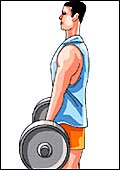|
Why
are we taking the name of some obscure Hanna-Barbara cartoon character
in an article about a cellular handset? Well, QD had to expand to
something, right?
Given my rather tedious, time-consuming experience
with the first Nokia N.Gage, let alone the part about looking stupid,
I did not expect much from the N.Gage Version 2, titled the QD.
Talking on that phone meant looking like a cross between a Mr. Spock
of Star Trek and Big Ears from Noddy comics.
But the QD soon began to impress. Firstly,
it is lighter, more compact and more ergonomic than the previous
phone. It is still a bit unwieldy to use, particularly for those
people who have become accustomed to Nokia's more traditional 'slim
candy-bar' type phones, but the earpiece is where you would expect
it to be. The buttons are not too awkwardly placed, but getting
proficient at messaging takes a little bit of time.
But, this is not why Nokia made the N.Gage
QD. It made it to play games on, and that is exactly what I did.
This is the best portable game machine I have used, and it is, as
I was reminded more than once, a phone to boot. Not that I really
appreciated being called in the middle of playing Ashen; the phone's
default setting means that a phone call takes priority over the
game.
The single-most important difference between
the first and second N.Gage is the hot-swappable card feature. On
the first N.Gage, one had to take out the battery and then change
the game (or memory) card. Now, one has to press a button, choose
the 'remove memory card' option, open a rubber strip and voila.
The QD got me through edit meetings, weddings,
traffic jams and other assorted boring stuff, playing Tiger Woods
Golf 2004 (which I have become quite good at, even if I say so myself),
Ashen and Spider-Man.
The games took full advantage of the N.Gage's
rather adequate screen; the graphics were not as bad as I expected
them to be (in fact, they were surprisingly good). The Java-based
games for the phone were a flashback to Arcade games from the 1980s
and they did take time to load. It may not be as much fun as playing
on your pc or through a console, but then again you will not find
your pc or console with you on the back seat of an Indica headed
towards Dadri.
I have never liked portable game consoles.
I am not particularly fond of the Game-Boy Advance, but the N.Gage's
bigger screen and dual functionality (one does need a phone, right?)
makes it quite useful. The price is not that bad as well-at a mrp
of Rs 11,599 (a Nokia 'Best Buy' price of around Rs 9,999), the
addiction factor only increases. I could not test the Bluetooth-enabled
multi-player gaming facility of the phone and the Nokia N.Gage arena
website is not complete in India as yet (assurances were given by
Nokia that it would be up and running by August), but since accessing
the web through GPRS is not the easiest thing to do, online gaming
might take some time.
The Nintendo Game-Boy Advance is a tad cheaper
at around Rs 6,000 and has several more games available, but it
is not available through legal routes. Then again, even though there
are only around 60-odd titles available on cards (initially at Rs
1,000 each), you can download more (albeit Java-based) games from
operator websites or Nokia's own website, for a lot less.
Of course, there is supposed to be the Playstation
Portable (PSP) heading for release by the end of the year, but chances
of that coming to India are minimal, at least for the time being.
So if you want the fun of portable gaming, the N.Gage QD is the
thing to buy. And as I will never tire of saying, it is a phone
to boot.
-Kushan Mitra
TREADMILL
BUTT, NATURALLY
 |
 |
|
A
|
B
|
It's
a part of the body that most men don't bother about-at least if
it's their own. But the butt is an important area of the body to
focus on for a variety of reasons. First, a taut and well-muscled
butt adds to the strength of the lower body and a good posture.
Try looking good in a pair of jeans if you have a wimpish butt and
you'll know what I mean. The butt (or the bum or the glutes) is
a prominent part of the body and it is easy to neglect its muscular
function. Your gait and your ability to move your hips and thighs
are all influenced by the state of your butt! More important, in
case you didn't know it, a man's sexual attractiveness is influenced
by the shape and size of his butt. Don't believe it? Ask a woman.
More seriously, each of your buttocks has three
muscles: the gluteus maximus, the gluteus medius and the gluteus
minimus. In gym slang, they're collectively referred to as the glutes.
The biggest of them is, as the name suggests, the gluteus maximus,
which is the largest and the most prominent and visible part of
the butt. The gluteus medius is the part that contracts to hold
the pelvis upright when you walk. And, finally, the gluteus minimus,
which lies under the medius and works in consonance with it. When
you twist your lower body (try touching your knees together), it's
these muscles that help in the movement. Ergo, a strong butt stabilises
the hip and pelvis.
So, what's the best workout for the butt? While
gymmers and trainers trot out a perplexing range of exercises-like
the bent-knee kickback, leg curls and lunges, I'd say it's the stiff-legged
deadlift that works the best. So does the squat. Call me old-fashioned
if you like, but I like "basic building block" exercises
like the squat and the deadlift. The squat is more common than the
deadlift but you're unlikely to encounter too many people doing
either of them, particularly in the new breed of effete gyms that
are springing up in the metros and the bigger cities. I'm going
to describe the deadlift-not the squat-in this instalment.
The exercise itself can look deceptively simple
(see Fig. A & B) but there are a couple of variants and a caveat.
First, the bent leg deadlift, which targets the glutes the best.
With feet flat beneath a bar, squat down and grab the bar with hands
shoulder width or a little wider. I suggest an overhand grip but
you could also use a mixed-one overhand another underhand-grip.
Now lift the bar by straightening hips and knees. If you do the
same exercise with your legs straight throughout the movement, it
also targets your hamstring muscles. Here's the caveat: you need
to keep your arms, knees and back straight throughout this exercise
otherwise, particularly if you're going heavy with the weights,
you can injure your back.
-Muscles
Mani
write to musclesmani@intoday.com
BUILD
UP YOUR BONES
Despite your mother's
advice, chances are you've given up your morning routine of milk
and Complan. No worries, says Batra Hospital's Ambrish Mithal. Milk
does the body good, but it's not crucial to the health of a 30-35
year old. Studies show calcium is most important in two life stages:
before the age of 20 and after 50.
TWO IMPORTANT STAGES: Bones are living, and
they grow, shrink and remould themselves. Until the age of 20, when
bones reach their peak weight, calcium is vital to building bone
density and length. After 30, bones lose about 1 per cent of their
weight yearly; that loss increases dramatically at age 50, when
it again becomes important to increase calcium-intake.
ONE COMPLICATION: People whose bone mass in
teen years was low have increased chances of getting osteoporosis,
a disease in which the bones become brittle (in severe cases, even
a sneeze can cause a fracture). But even if your original bone mass
was high, it is equally important to prevent excess calcium loss
in old age by stepping up calcium consumption.
THREE PREVENTIVE MEASURES: The most obvious
step to preventing osteoporosis is increasing body calcium by consuming
foods like low-fat milk, cheese, or broccoli.
The second step is increasing Vitamin D consumption,
which increases the body's absorption of calcium. Calcium cannot
leave the intestines and enter the bloodstream without it. Thirdly,
studies show weight-bearing exercises cause the bones to retain
and possibly gain density.
-Sushma Subramanian
|
